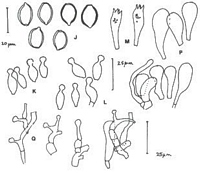|
 Conocybe sp. 3 Conocybe sp. 3
BiostatusPresent in region - Origin uncertain
Images (click to enlarge)
Caption: J-M, P-Q Segedin 219, J. Basidiospores; K-L Cheilocystidia; M. Basidia; P-Q Pileipellis units. |
Article: Watling, R.; Taylor, G.M. (1987). Observations on the Bolbitiaceae: 27. Preliminary account of the Bolbitiaceae of New Zealand. Bibliotheca Mycologica 117: 61 p. + 17 pl.
Description: Pileus 'small', brown when moist, hygrophanous, drying ochraceous tan with dark band around margin. Stipe hoary, with longitudinal brown lines. Gills almost free, clay brown.
Basidiospores lenticular, hexagonal to angled, broadly elliptic in face-view, flattened in side-view, 8-9(-10) x (5.5) 6-6.5 µm, x 5.5-6 µm, yellow brown in water and alkali solutions, thick-walled; germ-pore broad, central. Basidia cylindrico-clavate, 29-34 x 7-9 µm with foot 2.5-3 µm broad and basal clamp-connections. Cheilocystidia lecythiform, 13-17 x 5-7 µm, capitulum 3-5 µm broad. Pileipellis a palisadoderm of spheropedunculate cells 42 µm broad, some with encrusted pedicel, others with yellow vacuolar pigmentation, and intermixed with capitate cells, narrower than cheilocystidia, 19-33 x 3-6 µm with head <4 µm, many filled with persistent yellow plasmatic pigment. Stipitipellis of clamp-connected, parallel ± encrusted hyphae, with ± yellow plasmatic pigment dissolving in alkali solutions; caulocystidia similar in shape, or more variable than pilocystidia. Clamp-connections present.
Notes: This is obviously a distinct taxon but further collections are required to expand the field data. This agaric on spore-shape alone is close to the European C. antipus (Lasch) Fayod but lacks the elongation of the stipe into a long pseudorhiza. C. lenticulospora Walling, which also grows on dung and has lenticular basidiospores, is a member of sect. Pilosellae whereas Segedin 219 is assignable to sect. Conocybe. C. hexagonospora Metrod nomen nudum has similar sized spores but no type material can be traced (Heim, in litt.); it is reported as having some grey tints, and grew on burnt ground; see Bell's C. pubescens (1983)
|